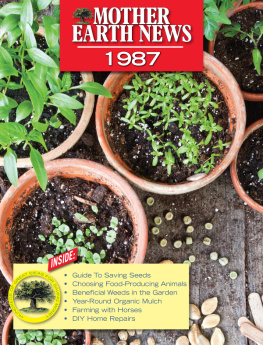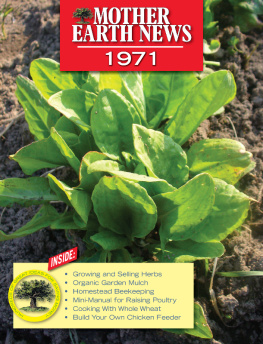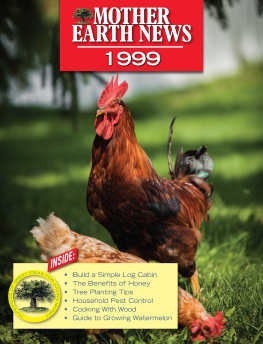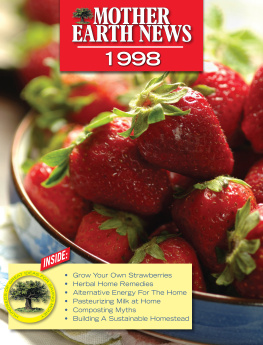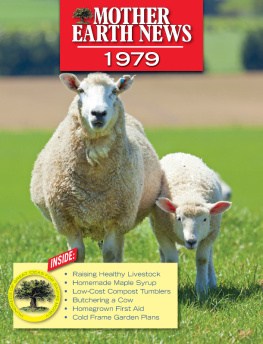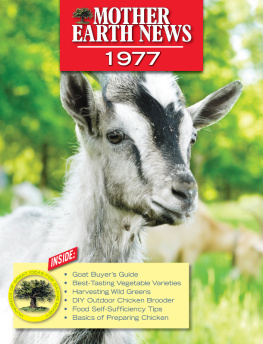Mother Earth News - Mother Earth News 2006
Here you can read online Mother Earth News - Mother Earth News 2006 full text of the book (entire story) in english for free. Download pdf and epub, get meaning, cover and reviews about this ebook. year: 2006, publisher: Mother Earth News, genre: Science / Home and family. Description of the work, (preface) as well as reviews are available. Best literature library LitArk.com created for fans of good reading and offers a wide selection of genres:
Romance novel
Science fiction
Adventure
Detective
Science
History
Home and family
Prose
Art
Politics
Computer
Non-fiction
Religion
Business
Children
Humor
Choose a favorite category and find really read worthwhile books. Enjoy immersion in the world of imagination, feel the emotions of the characters or learn something new for yourself, make an fascinating discovery.
- Book:Mother Earth News 2006
- Author:
- Publisher:Mother Earth News
- Genre:
- Year:2006
- Rating:3 / 5
- Favourites:Add to favourites
- Your mark:
- 60
- 1
- 2
- 3
- 4
- 5
Mother Earth News 2006: summary, description and annotation
We offer to read an annotation, description, summary or preface (depends on what the author of the book "Mother Earth News 2006" wrote himself). If you haven't found the necessary information about the book — write in the comments, we will try to find it.
Mother Earth News 2006 — read online for free the complete book (whole text) full work
Below is the text of the book, divided by pages. System saving the place of the last page read, allows you to conveniently read the book "Mother Earth News 2006" online for free, without having to search again every time where you left off. Put a bookmark, and you can go to the page where you finished reading at any time.
Font size:
Interval:
Bookmark:

Ever since tractors replaced horses, and then synthetic fertilizers and potent pesticides came on the scene in the mid-20th century, modern industrial agriculture has been producing bumper crops. But at the same time, this industrial system has depleted soil, polluted watersheds and treated animals inhumanely.
Most food is preserved, packaged and delivered to markets thousands of miles away. This system not only contributes to air pollution, but also aggravates our dependence on fossil fuels. Too much of the food that arrives at grocery stores is bland and unwholesome, and the oversupply contributes to an obesity epidemic for those of us who live in the midst of plenty.
Call it binge farming.
Now that were understanding the hangover symptoms this system has created, many of us are starting to pay more attention to exactly how and where the food we buy is produced. We are recognizing that we need to consider more than just which brand is the cheapest. We want to know how our food is grown and how the animals we eat are raised. We also want our patronage to have a positive effect on the farmers who produce our food.
Our best strategy is to grow some of our food at home; for what we cant grow ourselves, our best options are to buy directly from local producers or choose organic products from conscientious companies.
One indication that more and more of us are becoming conscientious about our food choices is the success of Organic Valley. As our article Doing Well by Doing Good explains, this unique farmer-owned cooperative has revolutionized the food business - producing organic dairy products sustainably and marketing them at prices that are fair to its farmers. Now with more than 700 member-farmers in 22 states, Organic Valley is expanding to offer meat, eggs and other organic products.
The success of Organic Valley is based on a steadfast commitment to two guiding principles: First, the cooperative exists to benefit its farmers. Second, no one - including the farmers - benefits if the co-ops actions harm the planet.
Every food purchase we make has consequences. Consumers choose Organic Valley products because they know they can feel good about all aspects of how the food was produced, as well as how the farmers who produced it are treated. We have the power to make better shopping choices that will force our agricultural system to sober up and act sensibly. Over the long run, Americans daily food choices will be a major factor in shaping the future of our society. We hope more farmers and businesses will follow Organic Valleys lead and give consumers better choices.
Imagine a renewable, clean-burning fuel that can be produced from local crops and could power a large number of existing vehicles - starting now. That fuel is biodiesel, which is made primarily of vegetable oil and alcohol and can be used in any modern diesel engine.
In the last few years, many farmers, environmentalists and other renewable energy advocates have begun promoting biodiesel as an alternative fuel that could replace at least a portion of the worlds petroleum-based diesel fuel market. Using biodiesel is an idea with widespread appeal because it pollutes far less than petroleum-based diesel and could help reduce our need for foreign oil.
In fact, biodiesel already is widely used in Europe, where tax policies are structured to support its use. In Germany - where diesel engines power close to 40 percent of passenger cars - more than 1,800 filling stations offer biodiesel at a price competitive with that of petroleum-based diesel fuel.
In the United States, the public is just becoming aware of the potential of biodiesel, but the development of a biodiesel industry is already well underway. Many Midwestern soybean farmers have joined forces with other entrepreneurs to build biodiesel production capacity and infrastructure. At the same time, federal and state agencies and independent organizations have been testing biodiesel performance and setting production standards.
With that firm foundation, the commercial biodiesel industry is growing rapidly, and biodiesel is becoming more accessible to drivers eager to fill their cars with this eco-friendly fuel. However, biodiesel can be used for more than fueling diesel-powered cars or trucks. In fact, the majority of the worlds heavy-transportation is diesel-powered, and all of these vehicles could be powered by biodiesel: buses, trucks, tractors, heavy machinery, boats and even trains. Biodiesel also can be used in any diesel-powered electrical generator, as well as in oil-fired furnaces and boilers (see Heat Your Home with Biodiesel).
Although diesel is part of its name, pure biodiesel does not contain any petroleum-based diesel, also called petrodiesel. Instead, biodiesel is created from organic matter. It can be made from virtually any vegetable oil, including soy, corn, rapeseed (canola), peanut or sunflower - as well as from recycled cooking oil, animal fats or even algae. Biodiesel has been called liquid solar energy because its energy content is derived from plants that capture solar energy during photosynthesis. The plants grown to produce biodiesel consume carbon dioxide (CO2), so they naturally balance most of the CO2 released when the fuel is combusted, offsetting a major contributing factor to global warming.
Using vegetable oil for fuel is not a new idea. When Rudolf Diesel invented the original diesel engine in the 1890s, he designed it to run on a wide range of fuels - including vegetable oils. But beginning in the early 1900s, diesel engines were adapted to burn mainly petrodiesel, a cheaper fuel. During the energy crisis of the 1970s, researchers began to reconsider vegetable oil fuels and found a simple method for turning vegetable oil into a usable diesel fuel. This process, called transesterification was developed in the late 1970s and early 1980s. It involves blending vegetable oil with alcohol, and adding a catalyst that will initiate the reaction that forms biodiesel.
Because the process for making biodiesel is relatively simple and can be extremely low-tech, it has attracted a global community of home brewers. Although industrial-sized biodiesel facilities use high-tech equipment, the process is basically the same for a small-scale facility located in a garage or backyard shed.
Heres how the process works. Carefully measured amounts of alcohol and vegetable oil are mixed with the catalyst. The alcohol can be either ethanol or methanol. (These two types of alcohol also are used in other types of fuel, see Biodiesel and other Biofuels.) For making biodiesel, methanol is usually preferred over ethanol because its less expensive and produces a more predictable reaction.
You can use one of two catalysts: sodium hydroxide or potassium hydroxide. Sodium hydroxide, which is commonly referred to as lye or caustic soda, is the same chemical used to unclog kitchen or bathroom drains. Potassium hydroxide can be used instead, but a larger quantity is required. These chemicals are dangerous and must be handled carefully.
Heres a basic example of how you would brew biodiesel, using methanol as the alcohol and sodium hydroxide (lye) as the catalyst. Methanol and lye are mixed to create sodium methoxide, which is then mixed with the vegetable oil and stirred or agitated - and sometimes heated. The catalyst causes the oil to react with the alcohol and form two byproducts: methyl esters (biodiesel) and glycerin. The biodiesel rises to the top of the tank while the glycerin and the catalyst settle at the bottom.
Font size:
Interval:
Bookmark:
Similar books «Mother Earth News 2006»
Look at similar books to Mother Earth News 2006. We have selected literature similar in name and meaning in the hope of providing readers with more options to find new, interesting, not yet read works.
Discussion, reviews of the book Mother Earth News 2006 and just readers' own opinions. Leave your comments, write what you think about the work, its meaning or the main characters. Specify what exactly you liked and what you didn't like, and why you think so.



